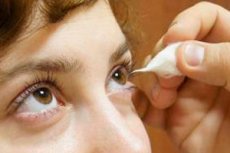
All iLive content is medically reviewed or fact checked to ensure as much factual accuracy as possible.
We have strict sourcing guidelines and only link to reputable media sites, academic research institutions and, whenever possible, medically peer reviewed studies. Note that the numbers in parentheses ([1], [2], etc.) are clickable links to these studies.
If you feel that any of our content is inaccurate, out-of-date, or otherwise questionable, please select it and press Ctrl + Enter.
Corneal sensitivity assessment
Medical expert of the article
Last reviewed: 04.07.2025

Indications for corneal sensitivity assessment
- Diseases of the cornea.
- Neuro-ophthalmological pathology.
Preparation for corneal sensitivity assessment
Equipment: a conical cotton wick with a thread-like end.
Who to contact?
Methodology and interpretation of corneal sensitivity assessment study
With the fingers of the left hand, spread the patient's eyelids, carefully touch the end of the cotton wick first to the center of the cornea, and then to four points on its periphery. If sensitivity is normal, the patient notices the touch or tries to close the eye. If this does not happen, then thicker parts of the wick are placed on the cornea. The appearance of a corneal reflex when placing a thicker part of the wick indicates a significant decrease in corneal sensitivity. If this method fails to evoke a corneal reflex, then sensitivity is absent.
Alternative methods for assessing corneal sensitivity
A more precise determination of corneal sensitivity is carried out using graduated hairs according to Frey-Samoylov. Corneal sensitivity is measured at 13 points of the cornea with three hairs (0.3: 1.0 and 10.0 g/mm squared). Algesimeters are also used, but the most advanced devices at present are optical-electronic esthesiometers.
 [ 10 ], [ 11 ], [ 12 ], [ 13 ], [ 14 ], [ 15 ], [ 16 ], [ 17 ]
[ 10 ], [ 11 ], [ 12 ], [ 13 ], [ 14 ], [ 15 ], [ 16 ], [ 17 ]

